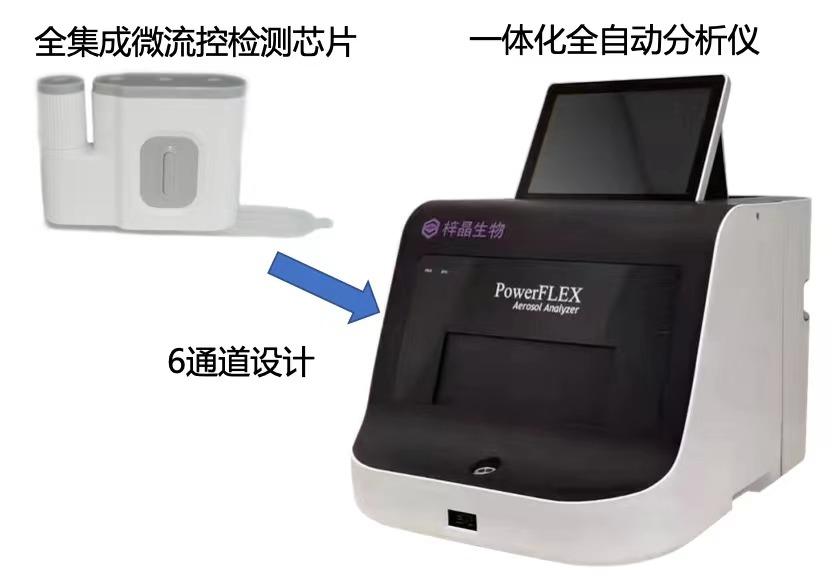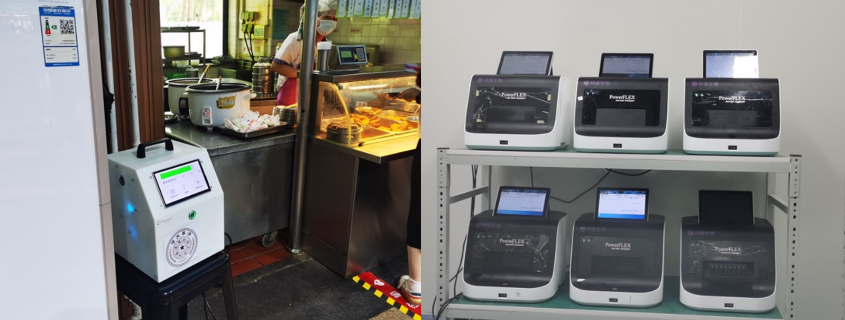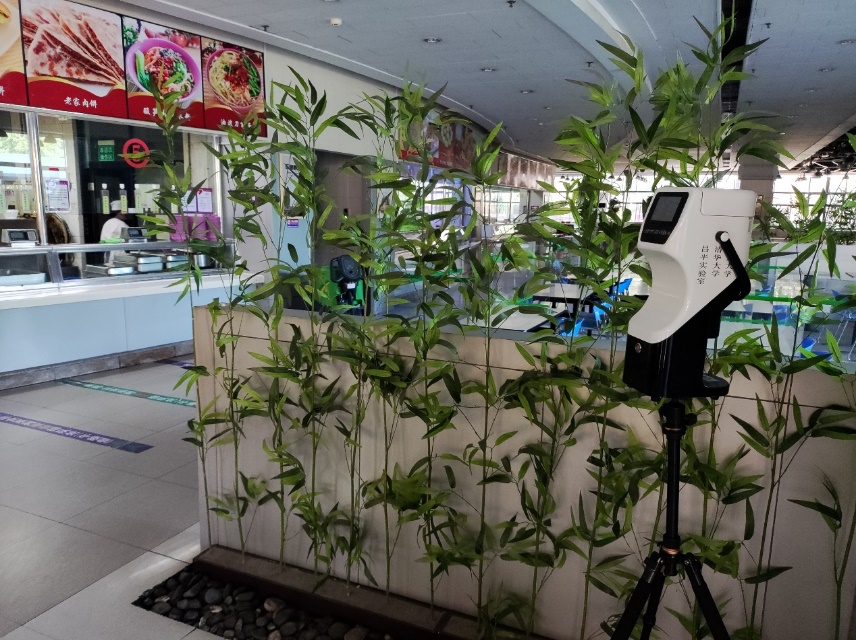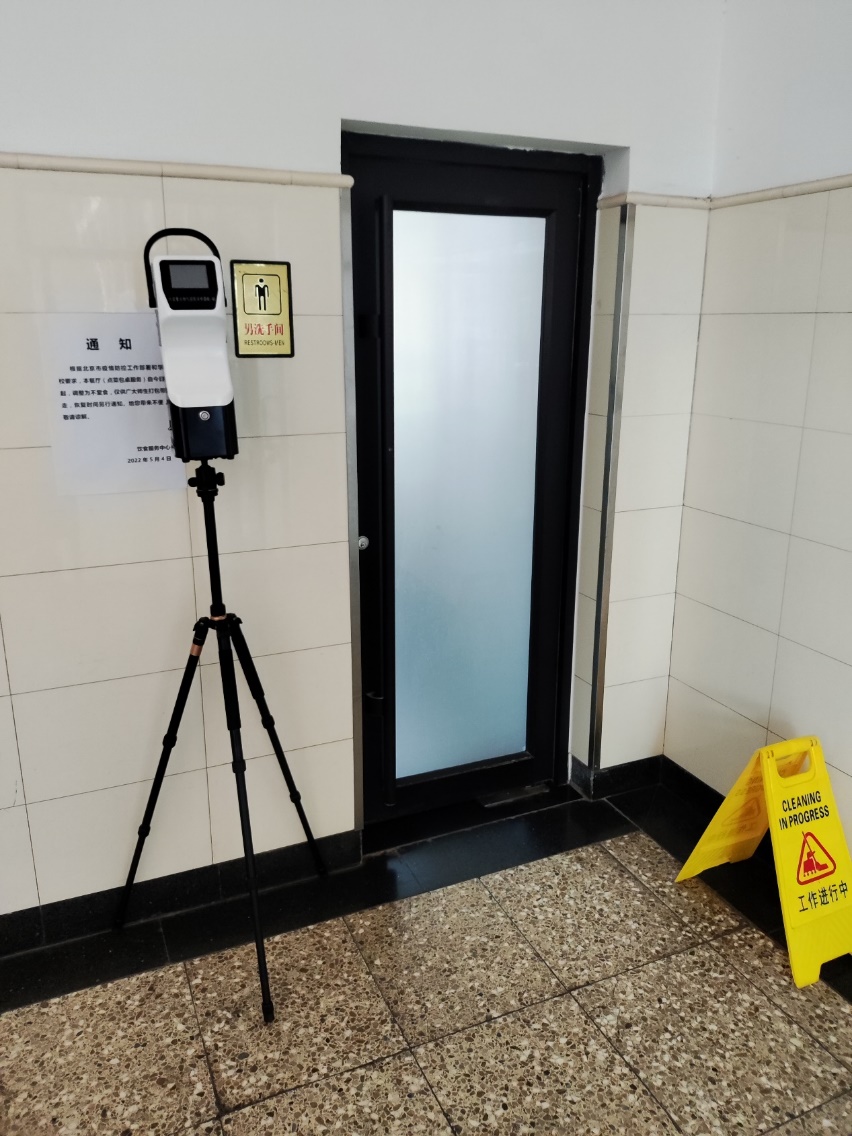You may have noticed that some mysterious devices have been placed in canteens and libraries recently. These ordinary-looking small boxes play an extraordinary role in protecting the campus – detecting airborne COVID-19 virus in public spaces.

Integrated and ultra- sensitive COVID-19 virus detector with excellent quantitative performance
This “magical” set of devices – capable of sampling indoor air and detecting Coronavirus-in- aerosol – is officially called the Bioaerosol Coronavirus Nucleic Acid Detection System for Public Spaces, first developed for the Beijing 2022 Olympic Winter Games by a team led by Liu Peng, an associate professor of the School of Medicine, Tsinghua University. This system was well received throughout the closed-loop of venues of the 2022 Olympic and Paralympic Winter Games.
Now, Professor Liu and Professor Jiang Jingkun from the School of Environment have teamed up to upgrade the Detection System and launched its 2.0 version in the Tsinghua campus, providing a strong technological support for the combat against COVID-19 on campus.
All-round improvements of sampling and detection

The upgraded Bioaerosol Coronavirus Nucleic Acid Detection System for Public Spaces
Just as in normal COVID-19 nucleic acid tests, sampling, transferring samples, and identifying the virus are the rigorous must-dos in airborne COVID-19 virus testing. The Detection System consists of a portable aerosol sampler, developed by Professor Jiang’s team, and an integrated, highly sensitive COVID-19 nucleic acid detector, developed by Professor Liu’s team, playing a vital role in sampling and detection, respectively. As a result, the 2.0 System has an enhanced performance in both sampling and detection compared to the system applied in the Olympic Winter Games.
“We have overcome two big challenges in sampling: improving the sampling efficiency with a higher sampling flow rate, and maintaining the viability of the virus more effectively when needed,” said Professor Jiang.
For collecting airborne virus aerosols air, low concentrations of aerosols have always been a challenge. The new-generation portable aerosol sampler not only greatly increases the flow rate, but also ensures the sampling efficiency, making air sampling easier than ever.
Meanwhile, Professor Jiang has drawn on his experience of Wuhan’s fight against COVID-19 in 2020, to make the sampler play a bigger role in future virus research. By combining the methods of droplet generation and cyclone separating, the sampler is able to maintain the viability of the virus to the greatest extent during collection, providing reliable conditions for subsequent virus incubation and identification.
As for the part of detection, Liu’s team launched a “Pro version” of their detector after the trials in the Olympic Winter Games.
“We used the method of isothermal amplification for detection during the Games, a method with rapid detection but lacking quantitative results. So now we have developed a PCR-based testing method using thermal cycling amplification that has high quantitative performance,” Professor Liu told the reporter.
If the air tests positive for COVID-19, which level of control measures should be taken becomes a key question. Quantitative results now come in handy as this question should be answered on the basis of such results. The detector indicates the Ct values to observe viral load quantitatively, offering a more scientific basis for subsequent decision-making as different levels of prevention and control measures are linked to different scopes of Ct values.
Well-selected sampling sites
In three libraries, six popular canteens such as Taoli Yuan and Zijing Yuan, and the Inflatable Sports Dome, 20 samples are collected from these sites and transferred every evening according to strict protocols to a testing laboratory in Changping District. Digital test reports usually come back to Tsinghua two hours later, assuring another day of safety to everyone breathing there with an entire column of negatives.
Then how should one select sampling sites on such an enormous campus to most accurately reflect the sanitary conditions?

A sampling point in a canteen
“Closed or semi-closed areas with people gathering, and places where aerosols are generated through the respiratory system when people take off masks are two major considerations in selecting sampling points,” answered Professor Jiang. In the crowded public places including the libraries, the canteens and the sports dome, every sampling site is selected based on rigorous consideration.

Taking samples in a library restroom
“Many sampling points are set in restrooms,” said Professor Liu, “because during the Olympic Winter Games, we found restrooms to be a place extremely prone to aerosol pollution. For one thing, people usually take off masks to clean their nose and mouth in the restroom, and for another, the virus also finds its way from the human digestive system to the toilet, which can easily generate aerosols when flushed. That’s why we are paying special attention to restrooms now.”

A staff member is operating the sampler
Samples from every sampling point are collected and transferred by specified, well-trained staff. The safety of the sampling staff is well guaranteed as the samples are processed with disinfectant and members wear N95 masks and gloves throughout the process.
This was another night when Professor Liu and Professor Jiang threw themselves back into research after checking the negative results from each sampling point.
The COVID-19 virus is “cunning and fickle” and has never stopped evolving. The two professors and their teams, just like other scientists and researchers in Tsinghua, have always held a belief in science in the face of the unknown.
Editors: John Olbrich, Li Han



